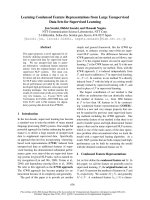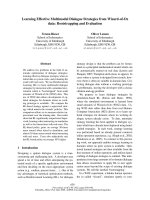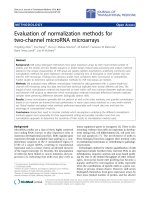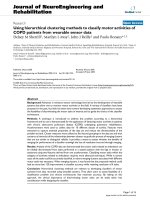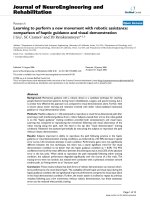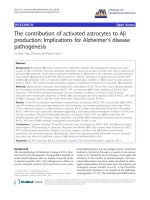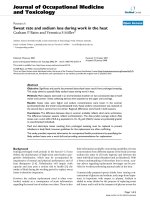Báo cáo hóa học: " Learning Rate Updating Methods Applied to Adaptive Fuzzy Equalizers for Broadband Power Line " pot
Bạn đang xem bản rút gọn của tài liệu. Xem và tải ngay bản đầy đủ của tài liệu tại đây (856.85 KB, 8 trang )
EURASIP Journal on Applied Signal Processing 2004:16, 2592–2599
c
2004 Hindawi Publishing Corporation
Learning Rate Updating Methods Applied to Adaptive
Fuzzy Equalizers for Broadband Power
Line Communications
Mois
´
es V. Ribeiro
Department of Communications, State University of Campinas, 13083970 S
˜
ao Paulo, Brazil
Email:
Received 1 September 2003; Revised 31 May 2004
This paper introduces adaptive fuzzy equalizers with variable step size for broadband power line (PL) communications. Based
on delta-bar-delta and local Lipschitz estimation updating rules, feedforward, and decision feedback approaches, we propose
singleton and nonsingleton fuzzy equalizers with variable step size to cope with the intersymbol interference (ISI) effects of PL
channels and the hardness of the impulse noises generated by appliances and nonlinear loads connected to low-voltage power
grids. The computed results show that the convergence rates of the proposed equalizers are higher than the ones attained by the
traditional adaptive fuzzy equalizers introduced by J. M. Mendel and his students. Additionally, some interesting BER curves reveal
that the proposed techniques are efficient for mitigating the above-mentioned impairments.
Keywords and phrases: power line communications, broadband applications, nonlinear equalization, fuzzy systems, learning rate
updating, impulse noises.
1. INTRODUCTION
In recent years, the increased demand for fast Internet ac-
cesses and new multimedia services, the development of
new and feasible signal processing techniques associated with
faster and low-cost digital signal processors, and the deregu-
lation of the telecommunications market have placed consid-
erable emphasis on the value of investigating hostile media,
such as power line (PL) channels [1, 2, 3], for high-rate trans-
missions. A considerable body of research h as given much
attention to indoor (last-meter, residential, or intrabuild-
ing) and outdoor (last-miles or local area networks and ru-
ral networks) PL environments for broadband applications
[2, 3, 4, 5, 6, 7, 8].
For last-miles environments, it has been demonstrated
that PL channels are as good as telephone and cable TV
channels for the transmission of broadband contents [1, 2,
3, 9, 10]. The capacity of PL channels for last-miles appli-
cations can surpass 450 Mbps [9]. Modems with bit rates
higher than 10 Mbps are nowadays offered by some compa-
nies. Nevertheless, a new generation of power line commu-
nications (PLC) modems that exceed 50 Mbps is appearing
[10].
Such improvement demands, however, some special
schemes or solutions for coping with the following prob-
lems in the physical layer: (a) the considerable differences
between PL networks; and (b) the hostile properties of
PL channels, such as attenuation proportional to hig h fre-
quencies and long distances, high-power impulse noise oc-
currences, and strong intersymbol interference (ISI) ef-
fects.
Equalization techniques are so far widely employed to
cope with ISI effects [11, 12, 13]. Among linear and nonlinear
equalization techniques available in the literature, adaptive
fuzzy equalizers are pointed out as good candidates to tackle
nonlinear features of the impulse noises and the severity of
the ISI effects, as postulated in [12, 13].
Aiming at the development of nonlinear equalization
techniques based on adaptive fuzzy systems for broadband
PLCs, this paper introduces singleton (S) and nonsingleton
(NS) fuzzy [14] equalizers with variable step size. Delta-bar-
delta (DBD) learning rule [15] and local Lipschitz estimation
(LLE) [16] are the methods chosen to tune the individual
step size of each free parameter of adaptive fuzzy equalizers.
The proposed fuzzy techniques emerge as interesting solu-
tions for the equalization of PL channels and mitigation of
impulse noises. In fact, PL channels change periodically, and
periodic PL channel equalizations with shorter training se-
quences are required to achieve high bit r a tes. The findings
reveal that such new techniques show higher convergence
rates than traditional adaptive fuzzy equalizers introduced
by J. M. Mendel and his students. Additionally, the proposed
techniques are able to equalize outdoor PL channels and also
mitigate impulse noises.
Adaptive Fuzzy Equalizers for Power Line Communications 2593
The rest of the paper is organized as follows. Section 2
gives a brief overview of PLCs in low-voltage grids. Section 3
focuses on the proposed techniques. Section 4 shows some
results of numerical simulations. Finally, Section 5 states
some concluding remarks.
2. POWER LINE COMMUNICATIONS IN LOW-VOLTAGE
GRIDS: AN OVERVIEW
Although not built for communication applications, the elec-
trical distribution circuits have been used for these purposes
since 1838. In the 1980s, several signal processing techniques,
such as error control coding and modulation techniques,
started to be implemented in hardware to achieve transmis-
sion rates up to 14.4 kbps. At the same time the CELENEC
standard emerged in Europe to address typical narrowband
applications at rates up to 144 kbps over distances around
500 m and maximum signal power of 5 mW [1]. Nowadays,
PL channels are used in frequency range between 1 and
30 MHz for broadband indoor and outdoor applications. In
this context, regulatory framework to harmonize the coex-
istence between PLC systems and radio services is manda-
tory since the radio services has been previously allocated in
the frequency range between 1 and 30 MHz. Recent investi-
gations supporting PLC and radio services interoperability,
coexistence, and electromagnetic compatibility estimate that
the power spectral density (PSD) of the data signal transmit-
ted on PLs must r a nge from −79 dBV
2
/Hz to −50 dBV
2
/Hz
[11]. The frequency response of the low-voltage distribution
network (LVDN) is given by [6]
H( f ) =
M
i=1
g
i
( f )
exp
ϕ
g
i
( f )
× exp
−
a
0
+ a
1
f
k
exp
− 2πfτ
i
,
(1)
where g
i
( f ) denotes the weighting factor in the ith multipath;
exp[−(a
0
+ a
1
f
k
)] is the attenuation term; exp(−2πfτ
i
)is
the delay portion in the ith multipath; and M is the number
of multipaths. Figure 1 illustrates the frequency response of
three PL channels.
For the frequency band from 1 to 30 MHz, the noise is
modeled as an additive contribution and expressed by [7]
η(n)
= η
bkgr
(n)+η
nb
(n)+η
pa
(n)
+ η
ps
(n)+η
imp
(n),
(2)
where η
bkgr
(n) is the background noise; η
nb
(n)isanar-
rowband noise; η
pa
(n) is a periodical impulse noise asyn-
chronous to the fundamental component of power system;
η
ps
(n) is a periodic impulse noise synchronous to the fun-
damental component of power system; and finally η
imp
(n)
is an asynchronous impulse noise. Figure 2 shows a typical
noise in the PL channel generated as in [7] in the frequency
band between 2 and 3 MHz. The PSDs of the colored back-
ground and impulse noises are equal to −130 dBV
2
/Hz and
0
−10
−20
−30
−40
−50
−60
−70
−80
−90
12 4 6 8 101214161820
Frequency (MHz)
Attenuation (dB)
Figure 1: Frequency response of three PL channels.
25
20
15
10
5
0
−5
−10
−15
−20
−25
×10
−3
0 5 10 15 20 25 30 35 40 45 50
×10
−3
Time (s)
Amplitude (V)
Figure 2: Additive noise in LVDN.
x(n)
h(n)
y(n)
η(n)
y(n)
w(n)
x(n − d)
Figure 3: Discrete time model of PL digital communication system.
−110 dBV
2
/Hz, respectively. The maximum amplitude of the
impulse noises, shown in Figure 2, is lower than 20 mV.
However, this value can be higher than 100 mV.
A discrete time model of a digital communication system
for PLC that takes into account the effect of ISI and the pres-
ence of additive noise is portrayed in Figure 3.
2594 EURASIP Journal on Applied Signal Processing
The symbol-spaced channel output is
y(n) = y(n)+η(n)
=
L
h
−1
k=0
h(k)x(n − k)+η(n), −∞ ≤ k ≤∞,
(3)
where the transmitted sequence x(n)istakenfrom{−1, +1}
and it is assumed to be an equiprobable and independent se-
quence with E{x(n− k)x(n − l)}=σ
2
x
δ(k − l)andE{x(n)}=
0. {h(n)}
L
h
−1
n=0
is the bandlimited, dispersive, and linear FIR
PL channel model whose frequency response is expressed
by (1). The additive impulse noise η(n)isgivenby(2)and
y(n) denotes the noise-free channel output. The channel
outputs observed by the linear equalizer
{w(n)}
L
w
−1
n=0
can be
written as vector y(n) = [
y(n) ··· y(n − L
w
+1)
]
T
∈
R
L
w
. The vector of the transmitted symbols that in-
fluence the equalizer decision is expressed by x(n) =
[
x( n) ··· x(n − L
w
− L
h
+1)
]
T
. As a result, there are n
s
=
2
L
w
+L
h
−1
possible combinations of the channel input se-
quence; and n
s
different values of the noise-free channel out-
put vector y(n) = [
y(n) ··· y(n − L
w
+1)
]
T
are possible.
Each of these noise-free channel output vector values is called
a channel output state vector y
j
, j = 1, , n
s
,givenby
y
j
= Hx
j
,(4)
where x
j
= [
x
j
(n) ··· x
j
(n − L
h
− L
w
+1)
]
T
denotes the
jth input vector and H is a matrix channel impulse response
given in the form of
H =
h
0
h
1
··· h
L
h
−1
··· 0
0 h
0
··· h
L
h
−2
··· 0
.
.
.
.
.
.
.
.
.
00h
0
··· h
L
h
−2
h
L
h
−1
. (5)
The equalizer output x(n − d) is a delayed form of the trans-
mitted sequence.
Based on the single-input single-output (SISO) concept,
the PL channels can be equalized by using two categories of
adaptive equalization techniques, namely, sequence estima-
tion and symbol decision. The optimal solution for sequence
estimation is achieved by using maximum-likelihood se-
quence estimation (MLSE) [17].TheMLSEisimplemented
by using the Viterbi algorithm [18], w hich determines the es-
timated transmitted sequence {x(n)}
∞
n=0
when the cost func-
tion defined by
J =
∞
n=0
y(n)
L
h
−1
k=0
h(k)x(n − k)
(6)
is minimized. Although this algorithm demands the highest
computational cost, it provides the lowest error rate when the
channel is know n.
The optimal solution for symbol decision equalization
is obtained from the Bayes probability theory [19]. The
normalized optimal Bayesian equalizer (NOBE) is defined by
f
b
y(n)
=
1
y
k
∈C
d
exp
−
y(n) − y
k
2
/2σ
2
n
×
y
i
∈C
+
d
exp
−
y(n) − y
i
2
2σ
2
n
−
y
j
∈C
−
d
exp
−
y(n) − y
j
2
2σ
2
n
,
(7)
where the noise source is assumed to be zero mean additive
white Gaussian with variance equal to σ
2
n
;andC
+
d
={y(n) |
x( n − d) = +1} and C
−
d
={y(n) | x(n − d) =−1} make up
the channel states matrix C
d
= C
+
d
∪ C
−
d
={y
j
},1≤ j ≤ n
s
.
Despite the optimality of the Bayesian equalizer, the clus-
tering or channel estimation techniques used to estimate the
channel output vector states demand prohibitive computa-
tional cost. The same problem is observed when an adaptive
implementation of the Bayesian equalizer based on a back-
propagation method [20] is per formed to adjust the Bayesian
free parameters.
3. THE PROPOSED FUZZY EQUALIZERS
Nonlinear equalization techniques based on computational
intelligence have been widely applied to mitigate ISI effects in
linear and nonlinear channels as well as to minimize the in-
fluence of non-Gaussian noises [12, 13, 14, 21, 22, 23, 24, 25,
26]. Among them, singleton type-1 fuzzy systems [12, 13, 14]
are pointed out to be a good solution for ISI and impulse
noise mitigations. In [24, 25], it was demonstrated that the
NOBE is a particular case of a singleton type-1 fuzzy sys-
tem and that its implementation as a fuzzy filter demands
low computational complexity. A substantial lower compu-
tational complexity is achieved if the method suggested in
[27] is applied.
Asfaraschannelequalizationisconcerned,morecom-
plexity reduction is attained when a decision feedback (DF)
structure [28, 29] is adopted to implement fuzzy equalizers.
In this case, let the order of the feedback branch L
b
be equal
to L
h
+ L
w
− d − 1, then the feedback vector can assume
n
b
= 2
L
b
states. Thus, the channel states matrix C
d
can be
divided into n
b
subsets. The new positive and negative chan-
nel state matrices are g iven by
C
++
d
=
y(n) | x(n − d) = +1 ∩ x(n − d) = +1
,(8)
C
−−
d
=
y(n) | x(n − d) =−1 ∩ x(n − d) =−1
. (9)
As a result, the related number of states in C
++
d
and C
−−
d
be-
comes equal to
n
ns
=
n
s
n
b
= 2
d
. (10)
Adaptive Fuzzy Equalizers for Power Line Communications 2595
z
−1
z
−1
z
−1
y(n) y(n − 1) y(n − 2) y(n − L
w
− 2) y(n − L
w
− 1)
Type-1 fuzzy system
f (y(n)) = x(n − d)
(a)
z
−1
z
−1
z
−1
y(n) y(n − 1) y(n − 2) y(n − L
w
− 2) y(n − L
w
− 1)
Type-1 fuzzy system
f (y(n))
z
−1
x(n − d − L
b
)
x(n − d − L
b
+1)
x(n − d − 2) x(n − d − 1)
z
−1
z
−1
Q(·)
x(n − d)
(b)
Figure 4: (a) FF structure. (b) DF structure.
It is noticed that the feedback branch reduces the number of
channel states required for the decision purposes, as in [29].
It is worth pointing out that the equalization of PL chan-
nels is not a simple task to be performed due to the following
reasons. (1) PL channel impulse responses for broadband ap-
plication are long. (2) The use of channel and channel states
estimation techniques demands high computational com-
plexity, even though a DF structure is implemented. (3) The
loss of optimality of the normalized Bayesian equalizer is fre-
quent if the probability of outlier occurrences is high.
For dealing with these inconveniences, Figure 4 depicts
the feedforward (FF) and DF structures of the proposed
fuzzy equalizers. For both approaches, the pdf of additive
noise in the PL channels is substituted by a nonsingleton
fuzzy membership [14, 30]. The output for both structures
is given by
f
y(n)
=
M
l=1
θ
!
L−1
i=0
exp
−
y(n − i) − m
F
l
i
2
/
σ
2
y
+ σ
2
F
l
i
M
l=1
L−1
i=0
exp
−
y(n − i) − m
F
l
i
2
/
σ
2
y
+ σ
2
F
l
i
,
(11)
where σ
2
y
is the var iance associated to each fuzzy input set,
and σ
2
F
l
i
as well as m
F
l
i
are the parameters of the Gaussian
membership function. The input vectors y(n) of the FF and
DF structures are equal to [
y(n)
··· y(n − L
w
+1)
]
T
and
[
y(n) ··· y(n − L
w
+1) x(n − d) ··· x(n − d − L
b
+1)
]
T
,
respectively. As can be noticed, this model takes into
consideration the occurrence of impulse noises. Based
upon nonsingleton assumption for PL noise distribution,
the normalized and optimal nonsingleton fuzzy equalizer
(NONFE) is given by
f
bns
y(n)
=
1
y
k
∈C
d
L
w
−1
i=0
exp
−
y(n − i) − y
k
(i)
2
/2
σ
2
y
+ σ
2
F
k
i
×
y
k
∈C
++
d
L
w
−1
i=0
exp
−
y(n − i) − y
k
(i)
2
2
σ
2
y
+ σ
2
F
k
i
−
y
k
∈C
−−
d
L
w
−1
i=0
exp
−
y(n − i) − y
k
(i)
2
2
σ
2
y
+ σ
2
F
k
i
,
(12)
where y(n
− i)andy
k
(i) are the ith output channel sample
and the ith element of the kth output state vector. Note that
if σ
2
F
k
i
is equal to a constant σ
2
n
, then
lim
σ
2
y
→0
f
bns
y(n)
σ
2
F
l
i
=σ
2
n
= f
b
y(n)
. (13)
The DF version of NONFE is obtained assuming that the
equalizer input vector is composed of output channel sam-
ples along with past output decisions. In this case, the state
matrices C
−−
d
and C
++
d
defined by (8)and(9), respectively,
substitute C
−
d
and C
+
d
in (12). As a result, the new C
d
matrix
is equal to C
−−
d
∪ C
++
d
.
These kinds of equalizers also make use of chan-
nel or channel state estimation techniques that demand
high computational complexity. Although the use of the
2596 EURASIP Journal on Applied Signal Processing
backpropagation method to update the free parameters of
these equalizers shows low computational complexity, it has
low convergence rate and often yields suboptimal solutions.
In this case, the use of updating step size techniques along
with the backpropagation method may be an interesting so-
lution to improve the convergence rate.
In this regard, DBD [15] and LLE [16] methods can be
good candidates for updating the step size associated with
each individual free parameter. These methods provide high
convergence rates as they try to find the proper learning rate
to compensate small magnitude of the gradient in the flat
regions and to dampen the large free parameter changes in
high-depth regions. From the author’s point of view, these
methods can be considered as a modified version of the back-
propagation method.
Regarding the first method, it is know n that the DBD
learning rule consists of a parameter vector updating rule
performed by a modified backpropagation procedure and a
learning rate rule defined by
∆w(n +1)=−(1 − α) diag
µ
0
(n), , µ
P−1
(n)
×∇J
w(n)
+ α∆w(n),
µ
i
(n +1)=
κ if λ
i
(n − 1)λ
i
(n) > 0,
−φµ
i
(n)ifλ
i
(n − 1)λ
i
(n) < 0,
0 otherwise,
(14)
respectively, where i = 0, , P − 1,
w(n)
=
w
0
(n) ··· w
P−1
(n)
T
(15)
denotes the free parameter vector of a specific fuzzy equal-
izer, µ(n) = [
µ
0
(n) ··· µ
P−1
(n)
]
T
is the learning rate vec-
tor, ∆w(n +1) = w(n +1)− w(n), α is the momentum
rate, λ
i
(n) = ∂J(w(n))/∂w
i
(n) is the partial derivative of the
cost function with respect to w
i
(n) at the nth iteration, and
λ(n) = (1 − δ)λ(n)+δλ(n − 1) is an exponential average of
the current and past derivatives.
Considering the second method, it is established that the
LLE method, in turn, is based on the estimation of the lo-
cal Lipschitz constant Λ in each free parameter direction
[16]. As far as adaptive fuzzy systems are concerned, neither
the morphology of the error surface nor the values of Λ are
known a priori. Then the estimation of Λ is obtained from
the maximum (infinity) norm given by
Λ(n +1)=
max
0≤i≤P−1
∇J
i
w(n +1)
−∇J
i
w(n)
max
0≤i≤P−1
w
i
(n +1)− w
i
(n)
.
(16)
As the shape of error surface to adapt a specific step size µ
i
=
1/Λ
i
(n +1),0≤ i ≤ P − 1, for each weight estimated in the
ith parameter direction, the fuzzy free parameters updating
Table 1: Additional computational cost associated with DBD and
LLE methods.
Computational
complexity
DBD LLE
Addition Ca (BP) + P Ca (BP) + P
Subtraction Cs (BP) + 2P Cs (BP) + 3P
Multiplication Cm (BP) + 3P Cm (BP) + 3P
Division Cd (BP) Cd (BP) + 2P
Comparison 3P 1
rule is given by
∆w(n +1)
=−λ(n) diag
µ
0
(n +1) , , µ
P−1
(n +1)
∇J
w(n)
,
µ
i
(n +1)=
1
Λ
i
(n +1)
=
w
i
(n +1)−w
i
(n)
∇J
i
w(n +1)
−∇J
i
w(n)
, i = 0, , P−1,
(17)
where the relaxation coefficient λ(n) must satisfy the follow-
ing condition:
∇J
i
w(n +1)
−∇J
i
w(n)
≤−
1
2
λ(n)
diag
µ
0
(n+1) , , µ
P−1
(n+1)
∇J
w(n)
2
.
(18)
The following rule is evaluated to u pdate λ(n).
If (18) is true, then
m = m − 1, λ(n +1)=
λ
0
q
m−1
, (19)
otherwise
m
= m +1, λ(n +1)=
λ
0
q
m−1
, (20)
where q ∈ R denotes the reduction factor, λ
0
is the initial re-
laxation coefficient, and m is a positive integer number. The
computational cost per iteration associated with the DBD
and LLE methods is shown in Tabl e 1. The total number of
free parameters P is expressed by
P =
M(2L + 1) + 1 if nonsingleton,
M(2L + 1) if sing leton,
(21)
where
L =
L
w
if FF structure,
L
w
+ L
b
if DF structure.
(22)
Adaptive Fuzzy Equalizers for Power Line Communications 2597
In Tab le 1 , Ca (BP), Cs (BP), Cm (BP), and Cd (BP) rep-
resent the computational complexity of the backpropaga-
tion method in terms of the number of additions, subtrac-
tions, multiplications, and divisions, respectively. Note, in
Table 1, that the computational complexity increments due
to DRD and LLE methods have been evaluated based on
computational complexity of the traditional backpropaga-
tion method. From Table 1, it can be stated that by using a
hardware solution (DSP or FPGA), a linear increase in the
computational complexity per iteration is observed when the
DRD and LLE methods are applied for tra ining fuzzy equal-
izers. Section 4 shows some results illustrating that this linear
increase of computational complexity can significantly im-
prove the convergence rate. As a result, the fuzzy equalizers
can be applied for periodical PL channel equalizations.
4. SIMULATION RESULTS
In this section, the convergence rate of the proposed fuzzy
equalizers called fuzzy-S-LMS-DRD, fuzzy-S-LMS-LLE,
fuzzy-S-DFE-DRD, fuzzy-S-DFE-LLE, fuzzy-NS-LMS-DRD,
fuzzy-NS-LMS-LLE, fuzzy-NS-DFE-DRD, and fuzzy-NS-
DFE-LLE are compared, under severe noise scenario, to the
previous equalizers which we name fuzzy-S-LMS, fuzzy-S-
DFE, fuzzy-NS-LMS, and fuzzy-NS-DFE [12, 13, 14, 24, 30].
For simplicity, only the results attained by using fuzzy-S-
DFE-LLE and fuzzy-NS-DFE-LLE equalizers are illustrated
in terms of BER performance.
The chosen PL channel and impulse noise models are
drawn from [6, 7], respectively. To obtain the BER curve, the
following considerations are observed: (a) the PL channel is
normalized; (b) the frequency range is between 1 MHz and
2.5 MHz; (c) the power of the transmitted BPSK symbols and
the impulse noise are equal to σ
2
x
= 0dBandσ
2
v
imp
= 0dB,re-
spectively; (d) the power of background noise varies from
−2.5dB to −20 dB; (e) L
w
, L
b
, M,andd are equal to 15,
8, 100, and 0, respectively; (f) the step size for the previ-
ous fuzzy equalizer is equal to 0.001; (g) α ∈ [0.1, 0.4],
κ ∈ [0.001, 0.0001], φ ∈ [0.6, 1.0], and the initial step size
is equal 0.03; (h) λ
0
, m,andq are equal to 4, 1, and 1.038,
respectively; (i) the same free parameter initialization condi-
tionswereappliedtoallanalyzedequalizers.
The convergence rates of the proposed FF and DF equal-
izers in terms of MSE measure when σ
2
x
= 0dB,σ
2
v
in
= 0dB,
and σ
2
bkgr
=−20 dB are shown in Figures 5 and 6,respec-
tively. As noted, the new techniques attain lower MSE values
with a smaller number of iterations than the previous fuzzy
equalizers. It is worth stating that all fuzzy equalizers with
the same structure will converge to the same MSE. The faster
convergence rate of the NS-LLE proposals is due to two rea-
sons.
The first reason refers to the fact that the nonsingle-
ton versions show at least the same convergence rate as
their equivalent singleton equalizers. In fact, the nonsingle-
ton fuzzy equalizers deal with the uncertaint y in the input
and, as a result, are able to mitigate the presence of impulse
noises more easily.
10
1
10
0
10
−1
012345678910
Iteration
MSE
Fuzzy-S-LMS
Fuzzy-NS-LMS
Fuzzy-NS-LMS-DRD
Fuzzy-S-LMS-DRD
Fuzzy-S-LMS-LLE
Fuzzy-NS-LMS-LLE
×10
4
Figure 5: FF fuzzy equalizers.
10
1
10
0
10
−1
10
−2
012345678910
×10
4
Iteration
MSE
Fuzzy-S-DFE
Fuzzy-NS-DFE-DRD
Fuzzy-S-DFE-LLE
Fuzzy-NS-DFE
Fuzzy-NS-DFE-LLE
Fuzzy-S-DFE-DRD
Figure 6: DF fuzzy equalizers.
The second reason refers to the efficiency of the training
method applied to fuzzy equalizers, which deserves consider-
able attention.
Figures 5 and 6 show that the LLE and DRD methods
provide the highest convergence rate while the use of the tra-
ditional backpropagation methods shows the lowest conver-
gence rate. Although more computational complexity per it-
eration is demanded by LLE and DRD methods (see Table 1)
the gain in terms of convergence rate is 5 times as high when
compared to fuzzy equalizers trained by backpropagation
method.
Figures 7 and 8 portray the BER performance of
the fuzzy-S-DFE-LLE, fuzzy-NS-DFE-LLE, DFE [28], and
Bayesian (optimal) equalizers [19] with and without error
propagation, respectively. The SNR values in these graphs
represent the relation between the power of the transmitted
symbols and the power of the background noises. Also, the
impulse noise power σ
2
v
in
= 0 dB was considered to configure
2598 EURASIP Journal on Applied Signal Processing
10
0
10
−1
10
−2
10
−3
2 4 6 8 10 12 14 16 18 20
SNR (dB)
BER
DFE
Fuzzy-DFE-S-LLE
Fuzzy-DFE-NS-LLE
Bayesian (optimal)
Figure 7: BER performance of DF equalizers with error propaga-
tion.
10
0
10
−1
10
−2
10
−3
2 4 6 8 10 12 14 16 18 20
SNR (dB)
BER
DFE
Fuzzy-DFE-S-LLE
Fuzzy-DFE-NS-LLE
Bayesian (optimal)
Figure 8: BER performance of DF equalizers without error propa-
gation.
a harsh PLC scenario. To get these numerical results, the
number of iterations ranged from 2 × 10
6
to 1 0
7
.
As can be observed, the proposed equalizers exhibit a bet-
ter performance than traditional DF equalizers. Traditional
fuzzy equalizers can also attain these results. However, this
demands at least 4 times the number of iterations spent to
obtain the convergence of the fuzzy-S-DFE-LLE and fuzzy-
NS-DFE-LLE equalizers. Although the BER performance of
the FF versions was not shown in this work, it is worth men-
tioning that it shows the worst results due to their innate fea-
tures.
5. CONCLUSIONS
This contribution has addressed the use of learning rate
updating methods to increase the convergence rate of the
adaptive fuzzy equalizers. On the basis of the results at-
tained, we can conclude that the proposed equalizers are
a satisfactory alternative solution to mitigate the hardness
of ISI and impulse noise effects for broadband PLC appli-
cations. The computational results appropriately illustrate
the applicability of these adaptive fuzzy equalizers revealing
that they are a new means of achieving high-rate tra nsmis-
sions at lower BER in PLC systems. Furthermore, they de-
mand fewer iterations than traditional fuzzy equalizers to
converge.
Further investigations are being carried out to analyze the
use of type-2 fuzzy systems with updating step size and to ex-
tend the analysis to other constellations. Another interesting
investigation is the use of the proposed fuzzy equalizers in
a turbo equalization scheme (see [31]) to reduce the num-
ber of turbo iterations required by the turbo fuzzy equalizer
convergence.
ACKNOWLEDGMENTS
We are sincerely indebted to the anonymous reviewers for
their valuable suggestions and comments. Special thanks
are extended to Patr
´
ıcia N. S. Ribeiro for proofreading
this contribution. The authors are also thankful to CAPES
(BEX2418/03-7), CNPq (Grant 552371/01-7), and FAPESP
(Grants 01/08513-0 and 02/12216-3) from Brazil for their fi-
nancial support.
REFERENCES
[1] N. Pavlidou, A. J. Han Vinck, J. Yazdani, and B. Honary,
“Power line communications: state of the art and future
trends,” IEEE Communications Magazine,vol.41,no.4,pp.
34–40, 2003.
[2] J. Abad, A. Badenes, J. Blasco, et al., “Extending the power line
LAN up to the neighborhood transformer,” IEEE Communi-
cations Magazine, vol. 41, no. 4, pp. 64–70, 2003.
[3] A. J. Han Vinck and G. Lindell, “Summary of contributions at
the international symposium on power line communications
and its applications,” in Proc. 5th International Symposium on
Power Line Communications and Its Applications (ISPLC ’01),
pp. 383–413, Malm
¨
o, Sweden, April 2001.
[4] F. J. Ca
˜
nete, J. A. Cortes, L. Diez, and J. T. Entrambasaguas,
“Modeling and evaluation of the indoor power line transmis-
sion medium,” IEEE Communications Magazine, vol. 41, no.
4, pp. 41–47, 2003.
[5] F. J. Ca
˜
nete, L. Diez, J. A. Cortes, and J. T. Entrambasaguas,
“Broadband modelling of indoor power-line channels,” IEEE
Transactions on Consumer Electronics, vol. 48, no. 1, pp. 175–
183, 2002.
[6] M. Zimmermann and K. Dostert, “A multipath model for the
powerline channel,” IEEE Trans. Communications, vol. 50, no.
4, pp. 553–559, 2002.
[7] M. Zimmermann and K. Dostert, “Analysis and modeling of
impulsive noise in broad-band powerline communications,”
IEEE Transactions on Electromagnetic Compatibility, vol. 44,
no. 1, pp. 249–258, 2002.
Adaptive Fuzzy Equalizers for Power Line Communications 2599
[8] P. J. Langfeld, M. Zimmermann, and K. Dostert, “Power line
communication system design st rategies for local loop access,”
in Proc. Workshop Kommunikationstechnik, pp. 21–26, Ulm,
Germany, July 1999.
[9] P. J. Langfeld, “The capacity of typical power line reference
channels and strategies for system design,” in Proc. 5th In-
ternat ional Symposium on Power Line Communications and Its
Applications (ISPLC ’01), pp. 271–278, Malm
¨
o, Sweden, April
2001.
[10] Ascom Power Line Communications AEG, “Nothing is as
powerful as an idea for which the time is ripe: Welcome to the
second discovery of electricity!,” June 2001, www.ascom.com.
[11] S. Qureshi, “Adaptive equalization,” Proceedings of the IEEE,
vol. 73, no. 9, pp. 1349–1387, 1985.
[12] M. V. Ribeiro, “On fuzzy-DFE-LMS and fuzzy-DFE-RLS al-
gorithms to equalize power line channels,” in Proc. IEEE Inter-
national Symposium on Industrial Electronics (ISIE ’03), vol. 2,
pp. 1001–1006, Rio de Janeiro, Brazil, June 2003.
[13] L X. Wang and J. M. Mendel, “Fuzzy adaptive filters, with
application to nonlinear channel equalization,” IEEE Transac-
tions on Fuzzy Syste ms, vol. 1, no. 3, pp. 161–170, 1993.
[14] J. M. Mendel, Uncertain Rule-Based Fuzzy Logic Systems: In-
troduction and New Directions, Prentice-Hall, Upper Saddle
River, NJ, USA, 2001.
[15] R. A. Jacobs, “Increased rates of convergence through learning
rate adaptation,” Neural Networks, vol. 1, no. 4, pp. 295–307,
1988.
[16] G. D. Magoulas, M. N. Vrahatis, and G. S. Androulakis, “Im-
proving the convergence of the backpropagation algorithm
using learning rate adaptation methods,” Neural Computa-
tion, vol. 11, no. 7, pp. 1769–1796, 1999.
[17] G. D. Forney Jr., “Maximum-likelihood sequence estimation
of digital sequences in the presence of intersymbol interfer-
ence,” IEEE Transactions on Information Theory,vol.18,no.3,
pp. 363–378, 1972.
[18] G. D. Forney Jr., “The Viterbi algorithm,” Proceedings of the
IEEE, vol. 61, no. 3, pp. 268–278, 1973.
[19] R.O.DudaandP.E.Hart, Pattern Classification and Scene
Analysis, John Wiley & Sons, New York, NY, USA, 1973.
[20] D. E. Rumelhart, G. E. Hinton, and R. J. Williams, “Learn-
ing internal representations by error propagation,” in Paral-
lel Distributed Processing: Explorations in the Microstructure of
Cognition, vol. 1, pp. 318–362, MIT Press, Cambridge, Mass,
USA, 1986.
[21] T. C. Chuah, B. S. Sharif, and O. R. Hinton, “Robust adap-
tive spread-spectrum receiver w ith neural net preprocessing
in non-Gaussian noise,” IEEE Transactions on Neural Net-
works, vol. 12, no. 3, pp. 546–558, 2001.
[22] S. Chen, G. J. Gibson, C. F. N. Cowan, and P. M. Grant, “Adap-
tive equalization of finite non-linear channels using multi-
layer perceptrons,” Signal Processing, vol. 20, no. 2, pp. 107–
119, 1990.
[23] Q. Liang and J. M. Mendel, “Equalization of nonlinear time-
varying channels using type-2 fuzzy adaptive filters,” IEEE
Transactions on Fuzzy Systems, vol. 8, no. 5, pp. 551–563, 2000.
[24] S. K. Patra and B. Mulgrew, “Fuzzy techniques for adaptive
nonlinear equalization,” Signal Processing,vol.80,no.6,pp.
985–1000, 2000.
[25] S. K. Patra and B. Mulgrew, “Efficient architecture for
Bayesian equalization using fuzzy filters,” IEEE Trans. on Cir-
cuits and Systems II: Analog and Digital Signal Processing, vol.
45, no. 7, pp. 812–820, 1998.
[26] M S. Yee, B. L. Yeap, and L. Hanzo, “Radial basis function-
assisted turbo equalization,” IEEE Trans. Communications,
vol. 51, no. 4, pp. 664–675, 2003.
[27]E S.Chng,H.Yang,andW.Skarbek, “Reducedcomplex-
ity implementation of Bayesian equaliser using local RBF net-
work for channel equalisation problem,” Electronics Letters,
vol. 32, no. 1, pp. 17–19, 1996.
[28] M. E. Austin, “Decision-feedback equalization for digital
communication over dispersive channels,” Tech. Rep. 437,
Research Laboratory of Electronics, MIT, Cambridge, Mass,
USA, August 1967.
[29] S. Chen, B. Mulgrew, and S. McLaughlin, “Adaptive Bayesian
equalizer with decision feedback,” IEEE Trans. Signal Process-
ing, vol. 41, no. 9, pp. 2918–2927, 1993.
[30] G. C. Mouzouris and J. M. Mendel, “Nonsingleton fuzzy logic
systems: theory and application,” IEEE Transactions on Fuzzy
Systems, vol. 5, no. 1, pp. 56–71, 1997.
[31] M. B. Loiola, M. V. Ribeiro, and J. M. T. Romano, “A turbo
equalizer using fuzzy filters,” in Proc. IEEE International Work-
shop on Machine Learning for Sig nal Processing (MLSP ’04),
S
˜
ao Lu
´
ıs, Br azil, September/October 2004.
Mois
´
es V. Ribeiro was born in Tr
ˆ
es Rios,
Brazil, in 1974. He received the B.S. degree
from the Federal University of Juiz de Fora,
Brazil, in 1999, and the M.S. degree from
the State University of Campinas (UNI-
CAMP), Campinas, Br azil, in 2001, both in
electrical engineering. He is currently work-
ing toward the Ph.D. degree at UNICAMP.
Mr. Ribeiro was a Visiting Researcher in the
Image and Signal Processing Laboratory of
the University of California, Santa Barbara, from January 2004 to
June 2004. He holds one patent. His fields of interests include filter
banks, computational intelligence, digital and adaptive signal pro-
cessing applied to power quality evaluation, and power line com-
munication. He was granted Student Awards by IECON ’01 and
ISIE ’03.
